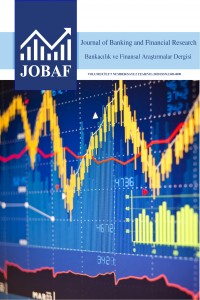Bermuda Triangle of Turkey: The Asymmetric Relationship between FX Markets, Stock Markets and Credit Default Swaps
Öz
In April 2019 Turkish authorities have tried to avoid a currency qualm before March local elections by orchestrating a market in which investors can’t move out of liras easily, In our study we focus impact of credit default swap (CDS) rate and stock market impact to FX markets in order to analyze whether the FX rates in the market is a natural balance of the market dynamics or an outcome of an engineered rate of Central Bank of the Republic of Turkey) CBRT and Turkish government policies. We utilized Impulse-Response analysis, Granger Causality Tests and EGARCH models to conclude that USDTRY rates are managed by the policy makers to provide favorable CDS rates and stock market returns.
Anahtar Kelimeler
Kaynakça
- Abid, Fathi.- Naifar, Nader. (2006), “The Determinants of Credit Default Swap Rates: An Explanatory Study”, International Journal of Theoretical and Applied Finance, Vol 09, pp. 23–42
- Black, F.- Scholes, M. (1973), “The Pricing of Options And Corporate Liabilities”. Journal of Political Economy, 81, pp. 637−654
- Blau, Benjamin. M. – Roseman, Brian. S. (2014), “The Reaction of European Credit Default Swap Spreads To The U.S. Credit Rating Downgrade”, International Review of Economics and Finance, 34, pp. 131-141
- Cappiello, L., Engle, S.K. (2006), Asymmetric dynamics in the correlations of global equity and bond returns. Journal of Financial Econometrics, 4(4), 537-572
- Chen, N.F.- Roll, R.- Ross, S. A. (1986), Economic forces and the stock market. Journal of Business, 59(3), pp. 383–403
- Duffie, D.- Singleton, K. (1999), “Modeling Term Structures of Defaultable Bonds.” Review of Financial Studies 12, pp. 687–720
- Engle, R. (1982), Autoregressive conditional heteroscedasticity with estimates of the variance of United Kingdom inflation. Econometrica, 50, 987-1007
- Eyssell, Thomas.- Fung, Hung.Gay.- Zhang, Gaiyan. (2013), “Determinants And Price Discovery of China Sovereign Credit Default Swaps”, China Economic Review 24, pp. 1–15
- Hamilton, J.- Lin, G. (1996), “Stockmarket volatility and the business cycle”. Journal of Applied Econometrics, 5, pp. 573–593
- Longstaff, F.A.- Pan, J.- Pedersen, L.H.- Singleton, K.J. (2011), “How Sovereign Is Sovereign Credit Risk”. American Economic Journal: Macroeconomics 3 (2), pp. 75– 103
- Merton, R. C. (1974), “On The Pricing of Corporate Debts: The Risk Structure of Interest Rates” Journal of Finance, 29, pp. 449−470
- Nelson, B.D. (1991), Conditional heteroskedasticity in asset returns: A new approach. Econometrica, 59(2), 347-370
- Norden, L.- Webber, M. (2009), “The Co-Movement of Credit Default Swap, Bond And Stock Markets: An Empirical Analysis”, European Financial Management, 15, pp. 529–562
Türkiye’nin Bermuda Şeytan Üçgeni: Kredi Temerrüt Takası, Kur ve Hisse Senedi Piyasaları Arasındaki Asimetrik İlişki
Öz
Nisan 2019'da Türkiye’de karar vericiler Mart’ta yapılacak olan yerel seçimlerinden önce bir döviz kurundan krizinden kaçınmak için yatırımcıların kolayca liraya karşı pozisyon almalarını engellemek için piyasalarda düzenleyici uygulamalara başvurdu. Bu çalışmada Kredi Temerrüt Takası (KTT) ve hisse senedi piyasalarının kur üzerindeki etkilerini incelereyek piyasada oluşan kur seviyesinin doğal bir denge sonucu mu yoksa karar vericiler ve Merkez Bankası tarafından üretilen politikaların bir sonucu olarak mu oluştuğu araştırılmıştır. EtkiTepki Analizleri, Granger Nedensellik Testleri ve Üssel Genelleştirilmiş Otoregresiv Koşullu Değişen Varyans (EGARCH) modellerini kullanarak dolar/TL kurunun politika yapıcılar tarafından uygun KTT oranları ve borsa getirileri sağlamak için baskılandığı sonucuna varılmıştır
Anahtar Kelimeler
ktt Döviz Piyasaları BIST1000 Swap EGARCH Modelleri Volatilite Modellemesi
Kaynakça
- Abid, Fathi.- Naifar, Nader. (2006), “The Determinants of Credit Default Swap Rates: An Explanatory Study”, International Journal of Theoretical and Applied Finance, Vol 09, pp. 23–42
- Black, F.- Scholes, M. (1973), “The Pricing of Options And Corporate Liabilities”. Journal of Political Economy, 81, pp. 637−654
- Blau, Benjamin. M. – Roseman, Brian. S. (2014), “The Reaction of European Credit Default Swap Spreads To The U.S. Credit Rating Downgrade”, International Review of Economics and Finance, 34, pp. 131-141
- Cappiello, L., Engle, S.K. (2006), Asymmetric dynamics in the correlations of global equity and bond returns. Journal of Financial Econometrics, 4(4), 537-572
- Chen, N.F.- Roll, R.- Ross, S. A. (1986), Economic forces and the stock market. Journal of Business, 59(3), pp. 383–403
- Duffie, D.- Singleton, K. (1999), “Modeling Term Structures of Defaultable Bonds.” Review of Financial Studies 12, pp. 687–720
- Engle, R. (1982), Autoregressive conditional heteroscedasticity with estimates of the variance of United Kingdom inflation. Econometrica, 50, 987-1007
- Eyssell, Thomas.- Fung, Hung.Gay.- Zhang, Gaiyan. (2013), “Determinants And Price Discovery of China Sovereign Credit Default Swaps”, China Economic Review 24, pp. 1–15
- Hamilton, J.- Lin, G. (1996), “Stockmarket volatility and the business cycle”. Journal of Applied Econometrics, 5, pp. 573–593
- Longstaff, F.A.- Pan, J.- Pedersen, L.H.- Singleton, K.J. (2011), “How Sovereign Is Sovereign Credit Risk”. American Economic Journal: Macroeconomics 3 (2), pp. 75– 103
- Merton, R. C. (1974), “On The Pricing of Corporate Debts: The Risk Structure of Interest Rates” Journal of Finance, 29, pp. 449−470
- Nelson, B.D. (1991), Conditional heteroskedasticity in asset returns: A new approach. Econometrica, 59(2), 347-370
- Norden, L.- Webber, M. (2009), “The Co-Movement of Credit Default Swap, Bond And Stock Markets: An Empirical Analysis”, European Financial Management, 15, pp. 529–562
Ayrıntılar
| Birincil Dil | İngilizce |
|---|---|
| Bölüm | Makaleler |
| Yazarlar | |
| Yayımlanma Tarihi | 6 Temmuz 2020 |
| Yayımlandığı Sayı | Yıl 2020 Cilt: 7 Sayı: 2 |

